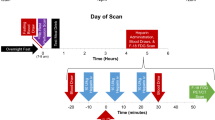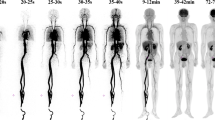Abstract
The goal of this study was to identify the anatomic and physiologic factors affecting left ventricular myocardial 2-[F-18]fluoro-2-deoxy-d-glucose (FDG) uptake and myocardial glucose utilization rates (MRGlc) in normal humans. Eighteen healthy male volunteers were studied in the fasting state (4–19 h) and 16 after oral glucose loading (100 g dextrose) with positron emission tomography (PET) and FDG. Substrate and hormone concentrations were measured in each study. The kinetics of myocardial FDG uptake were evaluated using both a three-compartment model and Patlak graphical analysis. Systolic blood pressures and rate pressure products were similar in the fasting and postglucose states. MRGlc averaged 0.24±0.17 μmol/min/g in fasting subjects and rose to 0.69±0.11 μmol/min/g after glucose loading. Phosphorylation rate constant, k3, and MRGlc were linearly related (P < 0.001). Increases in MRGIc following glucose loading were correlated with plasma glucose, insulin and free fatty acid concentrations, ratios of insulin to glucagon levels, and influx rate constants of FDG. Glucose loading improved the diagnostic image quality due to more rapid clearance of tracer from blood and higher myocardial FDG uptake. When MRGlc, glucose and insulin concentrations, and insulin to glucagon ratios exceeded 0.2 μmol/min/g, 100 mg/dl, 19 μU/ml, and 0.2 μU/pg, respectively, myocardial uptake of FDG was always adequate for diagnostic use. FDG image quality and MRGlc were similar after relatively short (6 ±2 h) and overnight (16 ± 2 h) fasting. Significant (P<0.05) regional heterogeneity of myocardial FDG uptake and MRGlc was observed in both the fasting and the postglucose studies. MRGlc and FDG uptake values in the posterolateral wall were higher than those in the anterior wall and septum. Thus, both 6-h and overnight fasts resulted in similarly low myocardial glucose utilization rates. While MRGlc and myocardial FDG uptake depended on plasma glucose, free fatty acid, and insulin concentrations, the results also suggest an additional dependency on plasma glucagon levels. Regional heterogeneities in myocardial FDG uptake and MRGlc are evident and independent of the subjects' dietary state. These regional heterogeneities need to be considered in studies of patients with cardiac disease.
Similar content being viewed by others
References
Tillisch JH, Brunken RC, Marshall RC et al. Prediction of cardiac wall motion abnormalities predicted by using positron tomography. N Engl J Med 1986; 314:884–888
Brunken RC, Tillisch JH, Schwaiger M et al. Regional perfusion, glucose metabolism and wall motion in chronic electrocardiographic Q-wave infarctions: evidence for persistence of viable tissue in some infarct regions by positron emission tomography. Circulation 1986; 73:951–963
Brunken RC, Kottou S, Nienaber CA et al. PET detection of viable tissue in myocardial segments with persistent defects at T1–201 SPELT. Radiology 1989; 1972:65–73
Schelbert HR, Schwaiger M. PET studies of the heart. In: Phelps ME, Mazziotta JC, Schelbert HR, eds. Positron emission tomography and autoradiography: principles and applications for the brain and heart. New York: Raven Press; 1986:581–661
Schelbert HR. Positron emission tomography for the assessment of myocardial viability. Circulation 1991; 84 Suppl I:I-122-I-131
Gropler RJ, Siegel BA, Lee KJ et al. Nonuniformity in myocardial accumulation of fluorine-18-fluorodeoxyglucose in normal fasted humans. J Nucl Med 1990; 31:1749–1756
Hicks RJ, Herman WH, Kalff V et al. Quantitative evaluation of regional substrate metabolism in the human heart by positron emission tomography. J Am Coll Cardiol 1991; 81:101–111
Berry JJ, Baker JA, Pieper KS et al. The effects of the metabolic milieu on cardiac PET imaging using fluorine- l8-deoxyglucose and nitrogen-l3-ammonia in normal volunteers. J Nucl Med 1991;32:1518–1525
Kuhle W, Porenta G, Huang SC, Phelps ME, Schelbert HR. Issues in the quantitation of reoriented cardiac PET images. J Nucl Med 1992; 33:1235–1242
Porenta G, Kuhle W, Czernin J et al. Gated PET FDG imaging permits parameter estimation of cardiac geometry: validation using gated MR imaging and echocardiography. J Nucl Med 1991;32:927
Phelps ME, Hoffman EJ, Selin CE et al. Investigation of [18F]2-fluoro-2-deoxyglucose for the measurement of myocardial glucose metabolism. J Nucl Med 1978; 19:1311–1319
Krivokapich J, Huang SC, Selin CE, Phelps ME. Fluorodeoxyglucose rate constants, lumped constant, and glucose metabolic rate in rabbit heart. Am J Physiol 1987; 252: H777-H787
Gambhir SS, Schwaiger M, Huang SC et al. Simple noninvasive quantification method for measuring myocardial glucose utilization in humans employing positron emission tomography and fluorine-18 deoxyglucose. J Nucl Med 1989; 30:359–366
Patlak CS, Blasberg RG, Fenstermacher JD. Graphical evaluation of blood-to-brain transfer constants from multiple-time uptake data. J Cereb Blood Flow Metab 1983; 3:1–7
Choi Y, Hawkins RA, Huang SC, Gambhir SS, Brunken RC, Phelps ME, Schelbert HR. Parametric images of myocardial metabolic rate of glucose generated from dynamic cardiac PET and 2-[18F]fluoro-2-deoxy-D-glucose studies. J Nucl Med 1991; 32:733–738
Sokoloff L, Reivich M, Kennedy C et al. The [I4C]deoxyglucose method for the measurement of local cerebral glucose utilization: theory, procedure, and normal values in the conscious and anesthetized albino rat. J Neurochem 1977; 28:897–916
Phelps ME, Huang SC, Hoffman EJ, Selin CJ, Sokoloff L, Kuhl DE. Tomographic measurement of local cerebral glucose metabolic rate in humans with (F-18)2-fluoro-d-deoxy-d-glucose: validation of method. Ann Neurol 1979; 6:371–388
Huang SC, Phelps ME, Hoffman EJ et al. Noninvasive determination of local cerebral metabolic rate of glucose in man. Am J Physiol 1980; 238: E69-E82
Ido T, Wan WN, Casella V et al. Labeled 2-deoxy-d-glucose analogs. 18F-labeled 2-deoxy-2-fluoro-d-glucose, 2-deoxy-2-fluoro-d-mannose, and 14C-2-deoxy-2-fluoro-d-glucose. J Label Compd Radiopharm 1978; 14:174–183
Padgett HC, Schmidt DG, Luxen A, Bida GT, Satyamurthy N, Barrio JR Computer-controlled radiochemical synthesis: a chemistry process control unit for the automated production of radiochemicals. Appl Radiat Isot 1989; 40:433–445
Weinberg IN, Huang SC, Hoffman EJ et al. Validation of PET-acquired input functions for cardiac studies. J Nucl Med 1988; 29:241–247
Hawkins RA, Phelps ME, Huang SC. Effects of temporal sampling glucose metabolic rates, and disruptions of the blood-brain barrier on the FDG model with or without a vascular compartment: studies in human brain tumors with PET. J Cereb Blood Flow Metab 1986; 6:170–183
Ratib O, Phelps ME, Huang SC et al. Positron tomography with deoxyglucose for estimating local myocardial glucose metabolism. J Nucl Med 1982; 23: 577–586
Fagan TC, Sawyer PR, Gourley LA, Lee JT, Gaffney TE. Postprandial alterations in hemodynamics and blood pressure in normal subjects. Am J Cardiol 1986; 58:636–641
Ferrannini E, Bjorkman O, Reichard GA et al. The disposal of an oral glucose load in healthy subjects. Diabetes 1985; 34:580–588
Neely JR, Morgan HE. Relationship between carbohydrate and lipid metabolism and the energy balance of heart muscle. Ann Rev Physiol 1974; 36:412–459
Opie LH. Fuels: carbohydrate and lipids. In: Opie LH ed. The heart: physiology and metabolism, 2nd edn. New York: Raven Press; 1991:208–246
Consoli A, Nurjhan N, Gerich J. Rates of appearance and disappearance of plasma lactate after oral glucose: implications for indirect-pathway hepatic glycogen repletion in man. Clin Physiol Biochem 1989; 7:70–78
Mitrakou A, Milde J, Michenfelder J, Gerich J. Rates of appearance and disappearance and brain lactate balance after oral glucose in the dog. Horm Metabol Res 1989; 21:236–239
Merhige ME, Ekas R, Mossberg K, Taegtmeyer H, Gould KL. Catecholamine stimulation, substrate competition, and myocardial glucose uptake in conscious dogs assessed with positron emission tomography. Circ Res 1987; 61 Suppl II: II-124-II-129
Busch-Sørensen M, Holst JJ, Lyngsøe J. Short time effects of growth hormone on glucose metabolism and insulin and glucagon secretion in normal man. J Endocrinol Invest 1991; 14:25–30
De Feo P, Perriello G, Torlone E et al. Demonstration of a role for growth hormone in glucose counterregulation. Am J Physiol 1989; 256: E835-E843
De Feo P, Perriello G, Torlone E et al. Contribution of cortisol to glucose counterregulation in humans. Am J Physiol 1989; 257:E35-E42
Emanuelsson H, Mannheimer C, Waagstein F. Changes of arterial levels and myocardial metabolism of catecholamines during pacing-induced angina pectoris. Clin Cardiol 1991; 14:567–572
Ng CK, Holden JE, DeGrado TR, Raffel DM, Kornguth ML, Gatley SJ. Sensitivity of myocardial fluorodeoxyglucose lumped constant to glucose and insulin. Am J Physiol 1991; 260: H593-H603
Schwaiger M, Hicks R. Regional heterogeneity of cardiac substrate metabolism? J Nucl Med 1991; 31:1757–1760
Porenta G, Kuhle W, Czernin J et al. Semiquantitative assessment of myocardial viability and flow from cardiac PET polar maps. J Nucl Med 1992; 33:1623–1631
Czernin J, Porenta G, Müller P et al. Perfusion defect extent determines LV function in patients with PET ischemia. Circulation 1991; 84:11–474
Tamaki N, Yonekura Y, Kawamoto M et al. Simple quantification of regional myocardial uptake of fluorine- l8-deoxyglucose in the fasting condition. J Nucl Med 1991; 32:2152–2157
Author information
Authors and Affiliations
Additional information
Laboratory of Biomedical and Environmental Sciences operated for the US Department of Energy by the University of California under Contract DE-FC03-87ER60615
Correspondence to: Y Choi
Rights and permissions
About this article
Cite this article
Choi, Y., Brunken, R.C., Hawkins, R.A. et al. Factors affecting myocardial 2-[F-18]fluoro-2-deoxy-d-glucose uptake in positron emission tomography studies of normal humans. Eur J Nucl Med 20, 308–318 (1993). https://doi.org/10.1007/BF00169806
Received:
Revised:
Issue Date:
DOI: https://doi.org/10.1007/BF00169806




